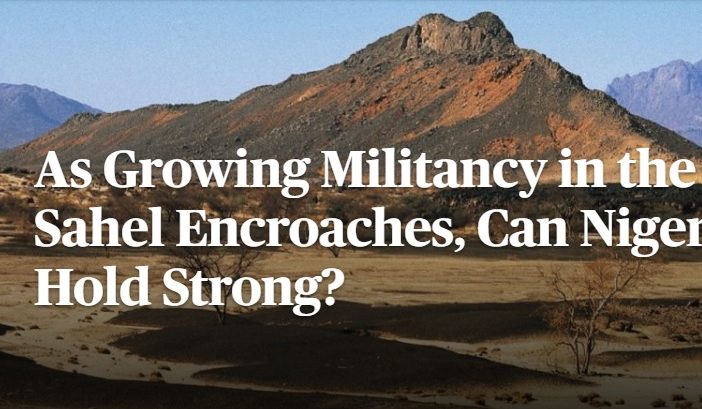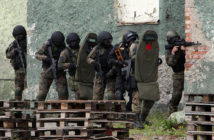Stratfor
Highlights
-
- As jihadist militants grow increasingly active in western Niger, the country will get pulled deeper into a regional emergency that broad security efforts have so far been unable to stem.
- Niger maintains some resilience against jihadist activity thanks to its close cooperation with and hosting of foreign troops, but even these efforts have been unable to keep Islamic State and Ansarul Islam militants at bay.
- Surrounded by conflict on all sides, militant groups may be drawn to the possibility of exercising direct control over the vast deserts of Niger, as well as merging battlefields across the Sahel.
Jihadist violence in Niger has been on the rise in the first half of 2019. Militants operating in Mali — many of whom expanded their operations into eastern Burkina Faso in 2018 — are now gradually forcing their way into the country. Attacks against population centers in rural border areas, as well as against local and foreign security forces, are occurring more regularly, illustrating the critical but precarious position Niger occupies in the broader Sahara-Sahel struggle for security.
Since jihadist activity emerged in Mali in 2012, militant groups have continued to spread across the Sahel region. The French regional Operation Barkhane has been unable to effectively stamp out or even limit the spread of this violence, which is now encroaching on Burkina Faso and Niger. Meanwhile, Niger already faces threats of spillover from conflicts in neighboring areas of Libya and Nigeria.
Violence of this nature has occurred in the Tillaberi region of Niger (bordering Mali and housing the capital city of Niamey) for some time, though it is increasing in intensity. Back in October 2017, jihadist militants ambushed a U.S. Green Beret unit in this area, drawing attention to the existing threat in the region. And since then, things have only gotten worse. The militants’ methods have been evolving, as evidenced by the emergence of roadside bomb attacks throughout the Tillaberi and Tahoua regions of Niger, and they have grown increasingly brazen, launching a successful raid directly against a Nigerien military base in the area.
Niger’s attempts to force back this violence have so far not been completely successful, just like similar attempts throughout the Sahara and Sahel area in general. Niger has been able to maintain a standard of security greater than its various neighbors, but the question of whether the country could fall to militant control is becoming more pressing. Niger’s ability to hold firm against jihadists will not only determine its own future stability; it will shape the future of militancy in the broader region and either deny or provide foreign forces the opportunity to use Niger as a stable base in their counterterrorism fight.
The most recent escalation of violence in the Tillaberi and Tahoua regions of Niger has been widely recognized as stemming from the ongoing conflict in Mali. Even though the Malian conflict has been ongoing since 2012, the jihadist groups that have emerged as the main actors in this theater — ISGS (Islamic State in the Greater Sahara), Jamaat Nusrat al-Islam wal-Muslimin and Ansarul Islam — have been aggressively expanding into eastern Burkina Faso since 2018. Now, in 2019, they’re looking toward Niger. Further embroiling Niger in Mali’s conflict is its membership in the G5 Sahel group, which has united regional countries in their armed struggle against jihadist groups. And despite these efforts to contain militancy in Mali, violence continues to spread and is now creeping into Niger.
Niger’s security woes don’t end there, however. It has also been facing a jihadist threat in the southeast at its border with Nigeria and Chad. This Lake Chad region is home to two competing ISWAP (Islamic State West African Province) factions that have occasionally forayed into Niger. Conflict has grown along its northern border with Libya and Chad as well. Even though violence there has not yet spilled over into Niger, Chadian rebel groups in Libya’s Fezzan area may well be interested in exploiting Niger’s porous border and northern rural desert areas. Surrounded on all sides by conflicts and challenged by active militant attempts to expand their fight, Niger finds itself in a position to stop the spread of jihadism and preserve its own security.
How Niger is Tackling the Challenge
Niger has received a lot of help in this fight. Several Western countries (including France, the United States, Germany, Italy and the Netherlands, among others) have established a military presence in the country, conducting active combat operations against jihadists, gathering intelligence, conducting logistics support and training and equipping Niger’s own security forces. And beyond Niger’s foreign military presence, Niamey is reportedly transforming into a secure area similar to Baghdad’s highly secured Green Zone, with private security personnel omnipresent. The concern over threats within Niger is great due to the various conflicts pushing against it, but at the same time, its position at the center of these conflicts provides it with a great potential to host the broader security response against it.
Niger’s tentative role as a secure oasis in a desert of conflict brings with it some burdens, however. To further its relationships with the European Union, which is an important provider of foreign security support, Niger has also been obligated to host thousands of refugees to help stem their flow to Europe. And despite the foreign force presence seemingly providing guaranteed security, it hasn’t served as a perfect solution to militant violence.
For Niger, the desire to prevent militant expansion goes far beyond the broader Western goal of combating global terrorism. In rural border areas, local Nigerien Tuareg nomads are playing a key part in the counterterrorism fight — and bearing the brunt of jihadist violence. Indeed, militants have specifically targeted Tuareg leadership in their increasing attacks along the Niger-Mali border because the Tuareg hierarchy enforces a degree of state control in these regions. The dispersed administration, which was not present in Mali in 2012 due to disagreements between the Tuareg and the Malian government, has significantly helped stem militant expansion into Niger.
The Militant Strategy and Goals
The jihadists’ tactic of trying to disrupt local representation by targeting tribal leadership is also occurring in Iraq, Syria and Afghanistan and is based on Abu Bakr Naji’s guidance in “The Management of Savagery.” Using this strategy, they aim to generate a power vacuum allowing them to expand their vast operational area into Niger. For these militants, the goal is not to take control of Niger or its main population centers necessarily — indeed, their activity follows centuries of established militancy patterns in the Sahara and Sahel regions.
Like that of neighboring countries, Niger’s geography is defined by large swaths of desert that, as mentioned previously, limit local and foreign governments’ ability to project power. While technology has enabled foreign and Nigerien troops to cover greater areas in this inhospitable terrain, it has by no means negated militants’ ability to evade security forces in its vastness. And since pre-colonial times, desert raiders originating from the Mediterranean coast and later from the nomadic Tuareg tribes have exploited this geography to evade the rule of law. (Government reach is typically stronger in the steppes and savannahs located south of the Sahara desert, where the Niger River basin also provides a source of sustenance.) Thus, the Nigerien government and its regional and foreign allies are not just fighting the militants themselves; they are also fighting the interplay of physical and human geography.
In more practical terms, this means the jihadist groups surrounding the vast deserts of Niger are extremely attracted to the country, having taken advantage of similar limitations on power projection and security vacuums in Mali, Nigeria and Libya. Niger, located right in the center, not only faces the risk of spillover violence from the now-established conflicts in these countries, but it also faces the added threat of becoming a focal point for militant groups aiming to connect their areas of operations and guarantee freedom of movement in the Sahel area. The most significant threats in this respect are the Islamic State factions in northeastern Nigeria and Mali. The Islamic State has even started to refer to both factions as the Islamic State West African Province, despite previously referring to the faction operating in and around Mali as the Islamic State in the Greater Sahara (ISGS). The shared name doesn’t mean that these groups now share a common command structure, but it’s notable for Niger that the Islamic State is encouraging the perception that battlegrounds reaching from Mali all the way to Lake Chad are part of a single objective.
For now, Niger’s combination of foreign support and local efforts continues to prevent the merging of the militant-controlled areas that surround it — especially in its southeastern territory, where jihadist factions have been almost completely unable to expand out of the Lake Chad area. To Niger’s west, however, the continuous expansion of jihadist activity raises the potential for further exploitation of Niger’s rural areas as part of a broader Sahel militant territory.








